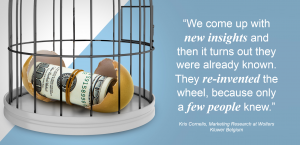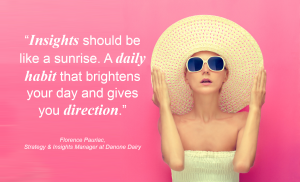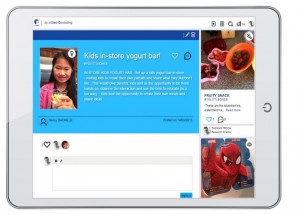By Anouk Willems
Time to reflect on the impact of consumer insights
Hello, summertime! For many of us, this is the time of the year when things slow down. Projects are put on hold, colleagues go on holiday, and if meetings can be postponed – they are! I think summer is a great time to reflect on the projects we have done, the rich consumer insights we found, and what the impact has been on the business. To get you started, here are 3 questions to think about:
Did you find rich new consumer insights this past year?
Did you share them extensively with your organization too?
Did your efforts trigger meaningful actions?
If the answer is 3 times ‘yes’, you probably had a very successful year! In most cases however, the last question is often the hardest part and more difficult to manage. Why? Well, after writing detailed market research reports, presenting the consumer insights and organizing ideation sessions, people tend to forget about the consumer insight. The insights are locked away in a PowerPoint report, and we move on to the next project. By doing so, the risk is that we lose sight of our insights, as market researcher Kris Cornelis explains:
“We come up with new insights and then it turns out they were already known. They re-invented the wheel, because only a few people knew.”
Kris Cornelis, Marketing Research at Wolters Kluwer Belgium
Hosting one workshop to generate ideas and translate actions is just not enough. In order to trigger meaningful actions across teams, it’s important to bring insights to life through interaction in a structural way. We do this by giving them a role in (further) shaping the insights. This way, an insight is ever evolving and kept fresh over time. The ultimate goal is that it becomes part of people’s work routines. Or as Florence from Danone describes it:
“Insights should be like a sunrise. A daily habit that brightens your day and gives you direction.”
Florence Pauriac, Strategy & Insights Manager at Danone Dairy
How to start with insight activation
Sounds great, right?! Unfortunately, there is no magic ‘insight activation’ button to push to make this a reality. So, how do we engage employees to collaborate with us and our consumer insights on a more frequent basis? And where do we begin? Let’s take the classical market research study to identify the first opportunities for insight activation.
Before: Harvest the collective mind.
The activation can already start before you find the insights. For example, Telefonica invited stakeholders to complete a SWOT exercise and add their predictions about the research outcomes. By inviting key stakeholders from different teams to share their learnings first, you are able to identify knowledge gaps. This way, you make sure that the insights you will find afterwards are ‘new’ and relevant to your internal stakeholders.
During: Share live updates from the field.
Why wait with sharing inspiring stories you heard or saw during fieldwork? As part of the activation, share striking observations during fieldwork as a teaser for the final insight report. For example, pharmaceutical company UCB decided to post their 2-3 ‘aha’ moments during in home visits and focus groups to spark discussions before the final report was shared. In this case, they used the Insight Activation Studio, a platform to collaborate around insights, observations and ideas.
After: Create empathy to trigger relevant actions.
After identifying the (validated) insights, the next step in activation is to let people recognize them and add their own observations to the insights. By doing so, we are creating more empathy with consumer’s routines and frictions. Once you established empathy with consumer frictions and routines, it forms the perfect start for generating ideas to solve the business problem.
This is also how Danone approached insight activation. After they identified rich shopper insights, they realized it was actually much more relevant for a larger audience than just the shopper teams at Danone. So, they created 6 interactive ‘Walls’ to put the employee in the shoes of the shopper in 6 different scenarios. Such a Wall is an interactive platform where employees can enrich insights by sharing own observations and ideas. For example, the #YoLittleOnes Wall. Parents face a challenge of constantly not giving in when their young children join them for grocery shopping. When kids show good behavior in the store, parents often want to give them a treat. These young kids are often attracted by the colorful packaging of unhealthy snacks. Employees enriched this Wall by sharing their own personal stories, resulting in more consumer centricity outside of the market research team.
Turning insights into memes
To increase the impact of a rich consumer insight and maximize the chance of triggering meaningful actions, all employees across the organization should learn about consumers’ frictions and routines in order to share related observations and ideas and build on them. When such an insight is replicated by employees and augmented with their own observations and ideas, shared with various people across the organization and triggers action, the insight becomes a ‘meme’.
I believe that many insights today are still locked away in reports, but have the potential to become a meme. What will be your ‘memes’ the coming year? Will this be your ‘summer of insights’? And how will you activate your insights when summer is over?
Anouk Willems is Head of Insight Activation Studios at InSites Consulting





